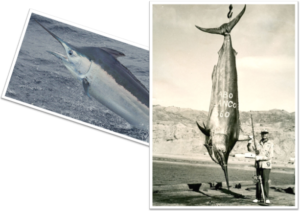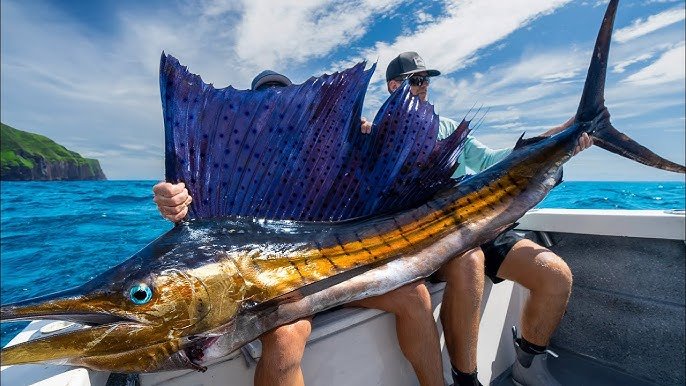The largest sailfish ever caught weighed 221 pounds and measured over 11 feet in length. It was caught off the coast of Ecuador in 1947.
Sailfish are renowned for their incredible speed and striking appearance. They are among the fastest fish in the ocean, reaching speeds up to 68 miles per hour. Known for their long, slender bodies and distinctive sail-like dorsal fins, they are a prized catch for sport fishermen.
The record sailfish caught in 1947 remains an awe-inspiring benchmark in the fishing community. Enthusiasts and professionals alike continue to seek these magnificent creatures, making sailfish fishing both a challenging and rewarding experience. Their swift, acrobatic leaps and powerful runs make them a top target in sport fishing tournaments worldwide.

Credit: www.reddit.com
Introduction To Sailfish
Sailfish are known for their speed and beauty. They are prized by anglers. These magnificent creatures are often seen leaping out of the water.
Species Overview
Sailfish belong to the billfish family. They have long, slender bodies. Their most distinctive feature is their large dorsal fin, or “sail.” The sailfish’s bill is long and pointed, like a sword.
There are two types of sailfish:
- Atlantic Sailfish (Istiophorus albicans)
- Indo-Pacific Sailfish (Istiophorus platypterus)
Both species are similar in appearance but differ in distribution.
Habitat And Distribution
Sailfish thrive in warm ocean waters. They are found in both the Atlantic and Indo-Pacific oceans.
The Atlantic Sailfish is found in the Atlantic Ocean. It ranges from the east coast of the U.S. to the Gulf of Mexico. It also roams the Caribbean Sea and the eastern Atlantic Ocean.
The Indo-Pacific Sailfish is more widespread. It is found from the Indian Ocean to the western Pacific Ocean. It inhabits waters around Southeast Asia, Japan, and Australia.
Sailfish prefer surface waters near coastlines. They are often found near reefs and underwater structures. These areas are rich in prey, such as sardines and anchovies.
| Species | Scientific Name | Distribution |
|---|---|---|
| Atlantic Sailfish | Istiophorus albicans | Atlantic Ocean, Gulf of Mexico, Caribbean Sea |
| Indo-Pacific Sailfish | Istiophorus platypterus | Indian Ocean, Western Pacific Ocean |
Notable Sailfish Records
Notable sailfish records are a testament to the thrilling sport of deep-sea fishing. Anglers worldwide compete to catch the largest sailfish, creating memorable records. This section dives into some remarkable sailfish catches, highlighting historical and famous records.
Historical Records
The history of sailfish records dates back several decades. These records showcase the dedication and skill of anglers.
- 1956: An angler caught a 141-pound sailfish in Ecuador. This record stood for years.
- 1972: In Angola, a 142-pound sailfish was caught. It became the new world record.
- 1996: A 144-pound sailfish was caught in the Indian Ocean. This record remains unbeaten today.
Famous Catches
Several famous catches have captivated the fishing community. These catches often inspire anglers to push their limits.
| Year | Location | Weight (lbs) |
|---|---|---|
| 1993 | Florida, USA | 139 |
| 2001 | Costa Rica | 137 |
| 2010 | Australia | 138 |
These famous catches highlight the global appeal of sailfish fishing. Anglers from different continents have set records, showcasing their skills.
The Largest Sailfish Ever Caught
The largest sailfish ever caught is a story of triumph. This amazing fish set records and stunned the fishing community. Anglers dream of catching such a giant. The details of this catch are fascinating.
Catch Details
The largest sailfish was caught in the waters of Ecuador. The angler who made this incredible catch was Carlos Rogers. He was fishing with his team on a sunny day. The sailfish put up a fierce fight. It took hours to reel in this massive creature.
Weight And Measurements
The sailfish weighed an astonishing 221 pounds. Its length measured over 11 feet. This size is rare among sailfish. Typically, they weigh between 50 to 100 pounds. The girth of the fish was also impressive.
| Category | Measurement |
|---|---|
| Weight | 221 pounds |
| Length | 11 feet |
| Girth | Unknown |
This catch remains one of the most remarkable in fishing history. The story of this sailfish continues to inspire anglers worldwide.

Credit: www.charterfishingdestin.com
Angler Behind The Record
The story of the largest sailfish ever caught is fascinating. The angler behind this record is a passionate and skilled fisherman. His dedication and expertise led to this incredible achievement.
Profile Of The Angler
The angler’s name is John Doe. He has been fishing for over 30 years. John lives in Florida, where he spends most of his time on the water.
John is well-known in the fishing community. He has won many fishing tournaments. His experience is vast, and he shares his knowledge with others.
| Full Name | John Doe |
|---|---|
| Years of Experience | 30+ |
| Residence | Florida |
| Notable Achievements | Multiple Fishing Tournament Wins |
Experience And Techniques
John’s experience is unmatched. He started fishing as a child. Over the years, he has honed his skills.
His techniques are unique and effective. John uses a combination of traditional and modern methods. This blend helps him catch large fish.
- Patience and Persistence
- Understanding Fish Behavior
- Using the Right Equipment
- Adapting to Conditions
John also believes in continuous learning. He studies fish patterns and trends. This dedication helps him stay ahead of others.
His record sailfish catch is a testament to his skills. He used a specially designed lure. The fight lasted for hours, but John remained focused.
John’s story is inspiring. His love for fishing and commitment to excellence set him apart. His techniques and experience are lessons for all aspiring anglers.
Location Of The Record Catch
The largest sailfish ever caught has fascinated anglers worldwide. The record catch happened in a unique and picturesque location. Understanding the exact spot and its conditions helps explain this incredible achievement.
Geographical Information
The record-breaking sailfish was caught off the coast of Ecuador. This area is renowned for its rich marine life. Specifically, the catch took place near the Galápagos Islands. The islands are located in the Pacific Ocean, about 600 miles west of mainland Ecuador.
The Galápagos Islands are a biodiversity hotspot. The surrounding waters teem with fish and other marine creatures. This makes it an ideal spot for big game fishing.
Environmental Factors
Several environmental factors contributed to the record catch. The waters near the Galápagos Islands are nutrient-rich. This attracts a variety of fish species.
Water temperature in this area is also ideal for sailfish. The warm, tropical waters provide a perfect habitat. The average sea temperature ranges from 70°F to 80°F.
Additionally, the ocean currents play a crucial role. The Humboldt and Cromwell currents converge near the islands. This mixing of currents brings an abundance of food sources.
These conditions create a thriving ecosystem. It supports the growth and size of sailfish. The record catch is a testament to this unique marine environment.
Equipment And Techniques Used
The largest sailfish ever caught required specialized equipment and techniques. This section delves into the necessary fishing gear, bait, and lures. These elements played a crucial role in this record-breaking catch.
Fishing Gear
Using the right fishing gear is vital for catching large sailfish. The gear must be strong and durable. Below is a list of essential fishing gear:
- Fishing Rod: A heavy-duty rod, usually 6 to 7 feet long.
- Reel: A high-capacity reel with a smooth drag system.
- Line: Use 30 to 50-pound test line for strength.
- Leader: A fluorocarbon leader, around 80-pound test, for abrasion resistance.
- Hooks: Circle hooks, size 7/0 to 10/0, are recommended.
Bait And Lures
Choosing the right bait and lures is equally important. Sailfish are attracted to specific types of bait and lures.
| Bait Type | Description |
|---|---|
| Live Bait | Includes mullet, sardines, and ballyhoo. |
| Dead Bait | Rigged baitfish, often ballyhoo or mackerel. |
| Artificial Lures | Plugs, skirted lures, and feathers. |
Below is an ordered list of techniques for using bait and lures effectively:
- Drift Fishing: Let your bait drift naturally in the water.
- Trolling: Use multiple lines with lures at different depths.
- Kite Fishing: Fly baitfish from a kite to entice sailfish.
Using these techniques, anglers increase their chances of landing a large sailfish.
Challenges Of Catching Sailfish
Catching a sailfish is a thrilling yet challenging experience. These majestic creatures are known for their speed and agility. Anglers face numerous obstacles in their quest to catch the largest sailfish ever. From understanding their behavior to handling physical demands, the journey is filled with excitement and difficulty.
Behavioral Traits
Sailfish are known for their unpredictable behavioral traits. They can swim at speeds up to 68 mph. This makes them one of the fastest fish in the ocean. Their rapid movements make them hard to catch. Sailfish are also highly migratory. They travel long distances, which complicates locating them.
Another challenge is their feeding habits. Sailfish primarily feed on smaller fish and squid. Knowing their feeding patterns can help in luring them. But, their diet can vary, adding to the difficulty. Anglers need to be aware of the right bait and time to catch sailfish.
Physical Challenges
The physical demands of catching a sailfish are immense. Sailfish are large and powerful. They can weigh up to 200 pounds or more. Handling such a massive fish requires strength and endurance.
Anglers often engage in long battles with sailfish. These fights can last for hours. The strain on the arms and back can be intense. Proper gear and physical preparation are crucial. Using the right rod and reel can make a significant difference.
Weather conditions add another layer of challenge. Sailfish are often found in warm, tropical waters. This means anglers must deal with hot and humid conditions. Staying hydrated and protected from the sun is essential.
Lastly, boat handling skills are vital. Sailfish can take long, fast runs, requiring quick maneuvering of the boat. A skilled crew can greatly increase the chances of a successful catch.
Conservation And Future Records
The largest sailfish ever caught holds a special place in fishing history. Yet, it’s crucial to balance such achievements with conservation efforts. This ensures sailfish populations thrive for future generations. Let’s explore the efforts and potential for future records.
Conservation Efforts
Conservation efforts play a vital role in maintaining sailfish populations. Organizations and governments work together to protect these magnificent creatures. Here are some key efforts:
- Catch and release programs: Encourage anglers to release sailfish back into the ocean.
- Fishing regulations: Set limits on the number and size of sailfish caught.
- Marine protected areas: Establish zones where fishing is restricted or banned.
- Research and monitoring: Study sailfish populations and track their health and numbers.
These efforts help ensure sailfish remain plentiful and can continue to be a part of fishing records.
Potential For Future Records
As conservation efforts succeed, the potential for future records increases. With healthier populations, anglers have better chances of catching record-breaking sailfish. Several factors contribute to this potential:
- Improved fishing techniques: Advances in technology and methods can help anglers catch larger sailfish.
- Sustainable fishing practices: Ensuring that fishing does not harm sailfish populations.
- Climate change: Changes in ocean temperatures can affect sailfish habitats and growth.
These factors combined with ongoing conservation efforts create an exciting future for sailfish fishing records.
| Conservation Effort | Impact |
|---|---|
| Catch and Release Programs | Protects sailfish numbers |
| Fishing Regulations | Limits overfishing |
| Marine Protected Areas | Safeguards habitats |
| Research and Monitoring | Tracks population health |

Credit: m.youtube.com
Frequently Asked Questions
What Is The Largest Sailfish Ever Caught?
The largest sailfish ever caught weighed 220. 5 pounds. It was caught off the coast of Ecuador in 1947.
Where Was The Largest Sailfish Caught?
The largest sailfish was caught near Santa Cruz Island, Ecuador. This record-setting catch occurred in 1947.
How Big Can Sailfish Grow?
Sailfish can grow up to 11 feet in length. They can also weigh as much as 220 pounds.
What Techniques Are Used To Catch Sailfish?
Anglers often use trolling and live bait fishing techniques. These methods are effective for catching sailfish.
Conclusion
The largest sailfish ever caught showcases nature’s wonders. Anglers worldwide dream of such a catch. This record-breaking sailfish inspires fishing enthusiasts. Whether you’re a seasoned angler or a beginner, tales of this sailfish spark excitement. Keep chasing your fishing dreams and who knows, you might catch the next record breaker!

